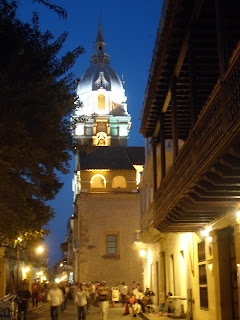 |
| Post - Spanish Qorikancha. |
The ancient Qorikancha in the Pre-Colombian times was the main temple of Cusco, the capital city of Incas. The Inca Empire (1438-1532) was the largest state of New World before the European conquest. It occupied the major part of modern Perú, Bolivia, Ecuador, north of Chile and northeast of Argentina. According to historians’ calculations, its population exceeded 9 million inhabitants.
 |
| Outside view of the Qorikancha Surprised by a rainbow - inspiration of the flag of Inca |
Tawantinsuyu was the word used by the Incas
to name their domains. In Quechua (the official language of the Inca Empire) it
means “the four parts of the World”. The Inca Empire was divided into four
provinces (suyus): Antisuyu (to the East from Cusco), Kuntisuyu ( to the West
from Cusco), Chinchasuyu ( to the
North from Cusco) and Qollasuyu (to the South from Cusco).
Incas remain in history as talented
warriors, politicians and architects. Their culture is outstanding for its
sophisticated technologies in ceramics, metallurgy, textiles, and especially in
architecture and engineering. Many of their creations, their palaces and
fortresses, roads and bridges, endure to our days.
Qorikancha of the Incas: Its’ history
 |
| Tawantinsuyu- the Incan Empire |
 |
| Three doors represent the past, the present and the future. |
Inca Pachakuti, the great reformer of the
Inca Empire, rebuilt the city of Cusco in the second half of the 15th
century and ordered new constructions to be made for the House of Sun.
Pachakuti provided the sanctuary with the fabulous treasures, the reason why it
changed its name to Qorikancha, which means in Quechua “gold enclosure”.
(According to the Spanish languange spelling, it is written as Coricancha;
according to the rules of the modern Quechua language it is spelled “Qorikancha”.)
The 16th century Spanish author
Pedro de Cieza de Leon describes the main Inca temple: “This temple had more
than four hundred steps in circumference, all surrounded by a big wall, the
whole building composed of excellent masonry, of fine stonework very well
adjusted, with some of the stones very big and of superb quality; (between
them) there was no mortar nor line, but kind of a bitumen which they commonly
use in their constructions, and the stones are so well worked that no mortar or
joint can be seen… There were many doorways, and the doors finely worked; along
the wall ran a gold band spans wide and four fingers high. The doors and the
doorways were plated with this metal…”
 |
| View from outside on the temple and Santo Domingo |
Qorikancha: deities and their cults
Colonial chronicle writers disagree in
numbers and description of the Inca deities venerated in Qorikancha and the
location of their respective precincts.
The celebrated author of mixed
Indian-Spanish origin Garcilaso de la Vega narrates in his Royal Comments that
the most important building was a temple dedicated to the Sun god (Inti),
located in the western part of the courtyard, where nowadays the Temple of
Saint Dominic is standing. On the door sides of the courtyard were the temple
dedicated to the Moon (Killa), the Sun’s wife; the temple of the planet Venus
(Ch’aska) and the stars (Qoyllur); that of the thunder and lightning (Illapa);
that of the rainbow (K’uychi) and the chamber of the high priest (Willaq Umu).
 |
| Outside the Santo Domingo Ancient Qorikancha |
Father Barnabo Cobo in his History of the
New World says that the most important image of the Qorikancha was called
P’unchau: “It was a sculptured image called Punachau, which means ‘day’, all
made of the finest gold, with exquisite richness of jewelry, his figure with a
human face, surrounded with rays, like we use to paint (the sun); it was placed
in such a way that it faced the east, and when the sun came out, its light fell
on the image; and as it was a very fine metal plate, the sun rays reverberated
and were reflected with such a shining that it looked like sun itself. Indians
said that together with its light, the sun communicated its virtue to the
image”.
The Indian author Juan de Santa Cruz
Pachacuti affirms that the main deity venerated at Qorikancha was the creator
go Viraqocha, who was represented by the oval gold plate.
Besides all these deities, mummies of the
Inca emperors and their wives were venerated at Qorikancha, as ancestors
protectors of the royal dynasty and the whole
Empire.
 |
| A walls with windows in one of the rooms in the temple. |












































